MY CLASSICS
Renault Mégane Scénic
Cars
| 21-02-2020
When Renault launched the Mégane Scénic in 1996, it was a hit: the right model at the right time. That, of course, is what every company wants when launching a new product. How did Renault pull that off?
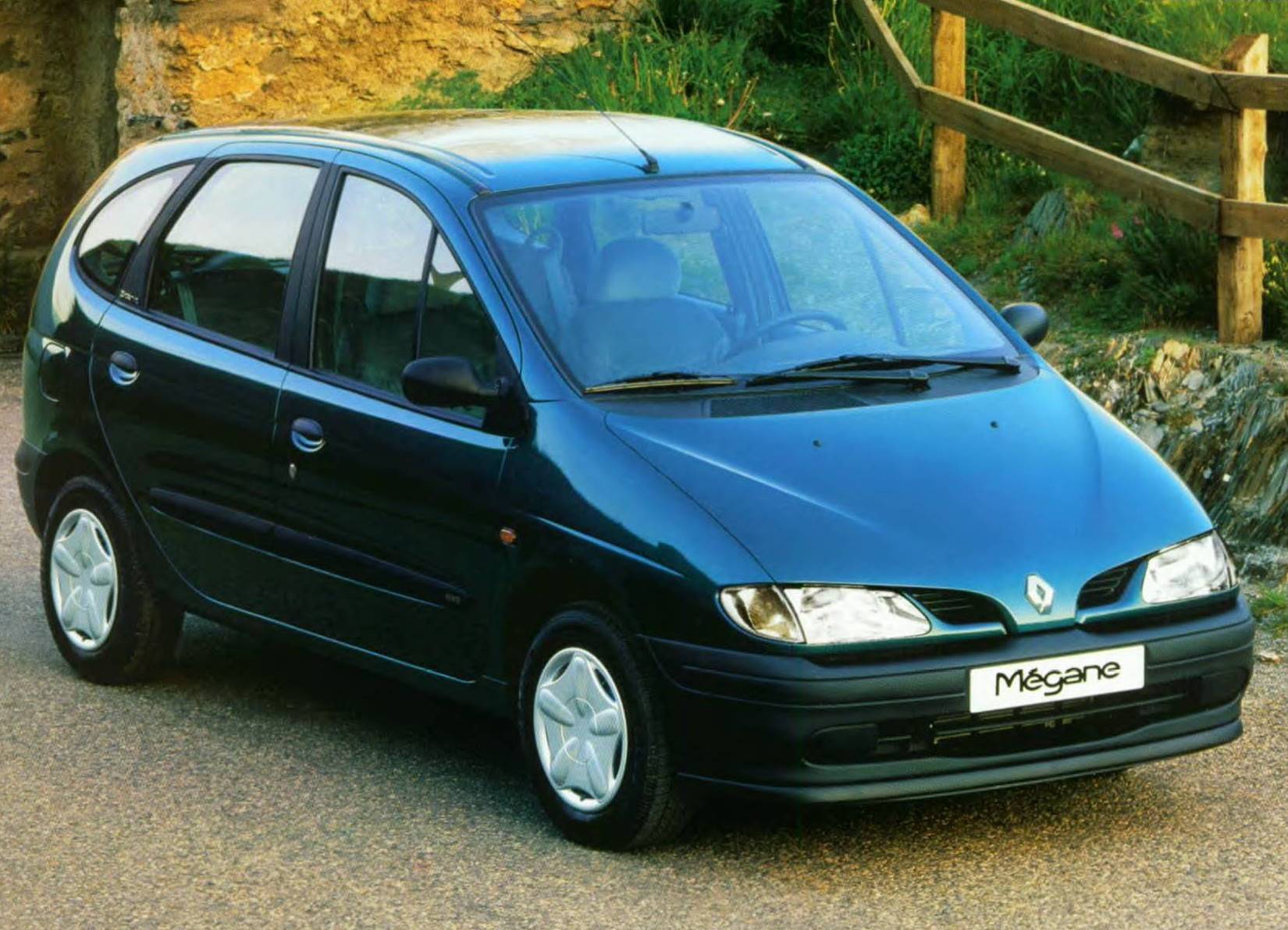
In 1995, Renault presented the Mégane as the successor to the 19, initially only as a five-door hatchback and as a three-door hatchback that was given the name 'Coupé'. In the same year I, a 12 year old boy, received a booklet for Sinterklaas, entitled 'Alle Auto's 96' ('All Cars 96'). Every year in December a new part came out, with the date of the coming year in the title. In that booklet was an image of the new Mégane in various body styles, some of which had not yet been revealed. At the time, an average model series of compact family cars consisted of a 3-door and 5-door hatchback, a sedan and station wagon, possibly supplemented with a coupé and/or convertible. In the case of the Mégane, however, there was no station wagon (or break, as the French often call such a model), but a high model, a kind of small Espace.
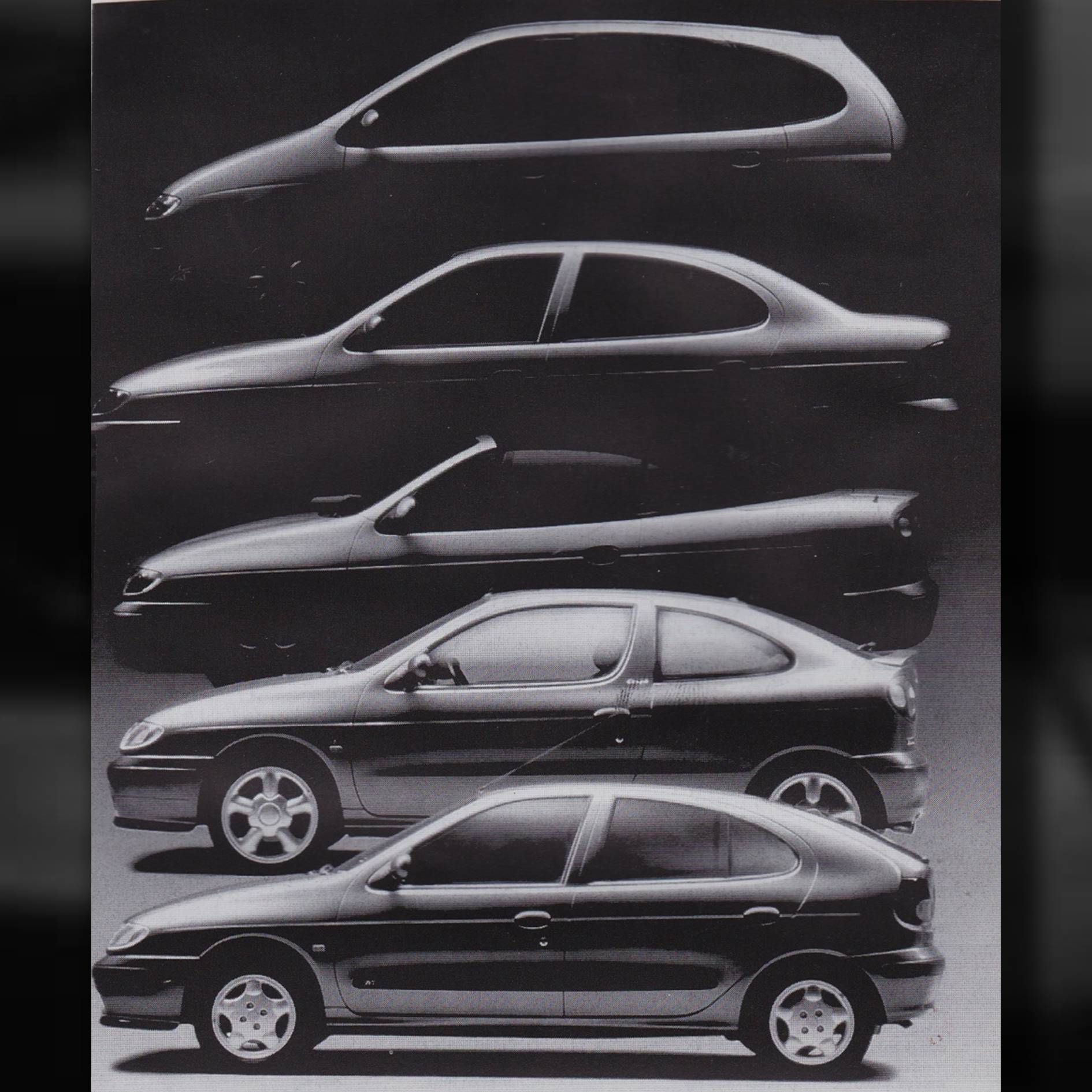
It is of course impossible to say with certainty how I would have described the Mégane Scénic in 1995 when I saw that first, darkened image. I may or may not yet have known the term 'MPV'. But I certainly knew the Espace, Renault's large family van. (To European standards it is a large car, but in the US people carriers like this are called mini vans...). I therefore think there's a good chance I would have described the new phenomenon that was the Mégane Scénic as 'little Espace'. That probably applied to many people at the time. And with reason. Renault had already taken on the role of precursor – whether they really were, I'll leave aside for now – at the introduction of the first Espace in 1985. The design came from Matra, who first offered it to Peugeot. When that brand refused the model, they went to Renault, which jumped at it. In 1985 the car came on the market as Espace. A striking name, because it surely did offer a lot of espace (space). The model turned out to do well enough to justify a successor, and in 1991 the second generation Espace was presented. When MPV's came into fashion in the mid-1990s, Renault already had years of experience and their brand name in Europe was already inextricably linked to that concept. Where Renault's largest European competitors focused on the development of an Espace-like car (the Citroën Evasion/Fiat Ulysse/Peugeot 806 hit the market in 1994, the Ford Galaxy/Seat Alhambra/VW Sharan in 1995-1996 and the Opel Sintra in 1997), Renault could already think one step further, towards a midi-MPV.
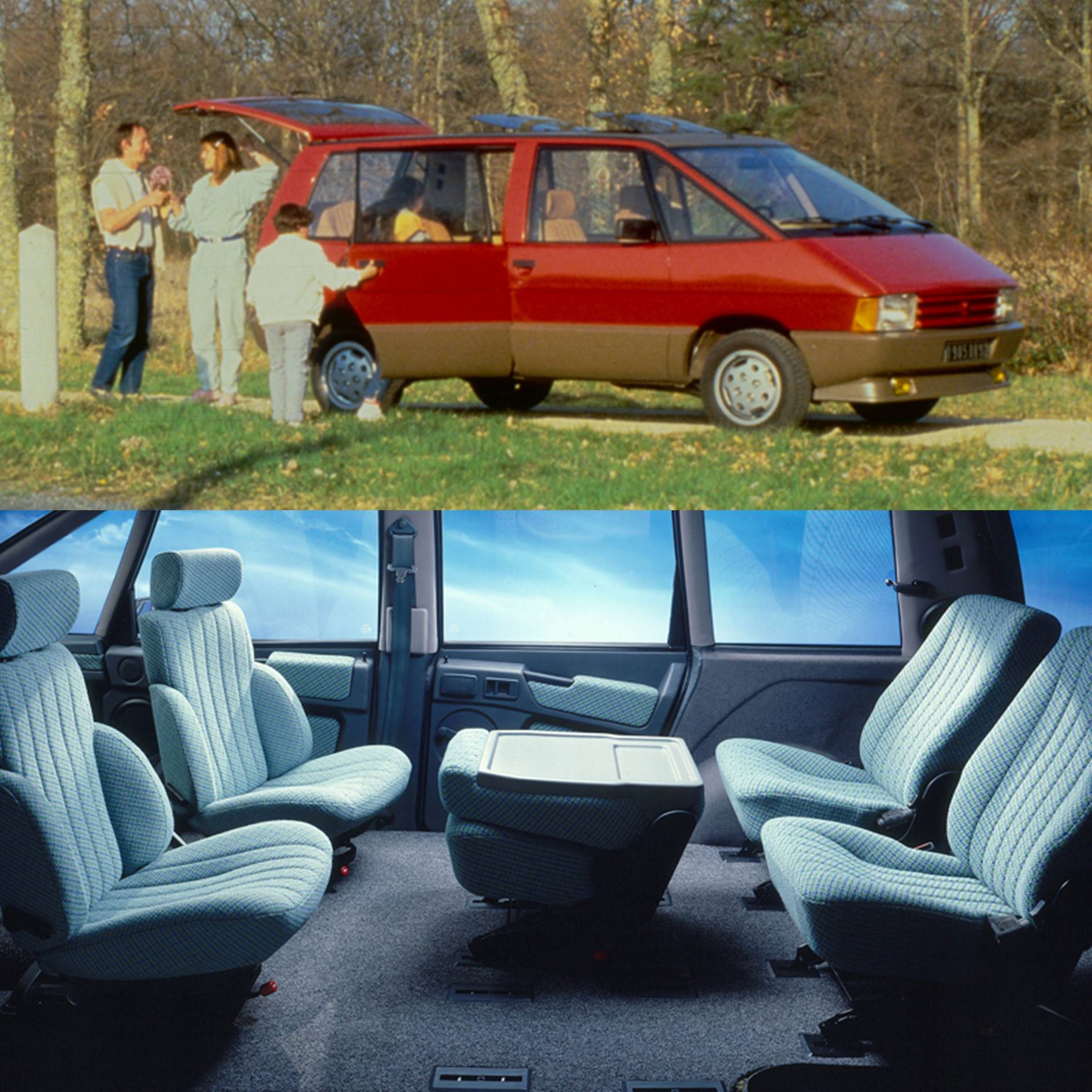
Before the Mégane Scénic saw the light of day, Renault had already added another MPV next to the Espace: the Twingo. It may be a bit too far to see that car as an MPV, but for a small city car it offered a remarkable amount of interior space. Renault later advertised with the Twingo, Mégane Scénic and Espace as a mono-volume line-up. With the Twingo, Renault also profiled itself as a forerunner, although in Japan a car with a similar concept was already for sale under the Honda brand, and in Europe Citroën, for example, had already considered a similar concept for the AX. That of course doesn't alter the fact that it was Renault that had the courage to bring such a remarkable model to the European market. And that it contributed to the image of Renault, as a brand that, in addition to rather 'average' models, was also strong in smart space concepts.
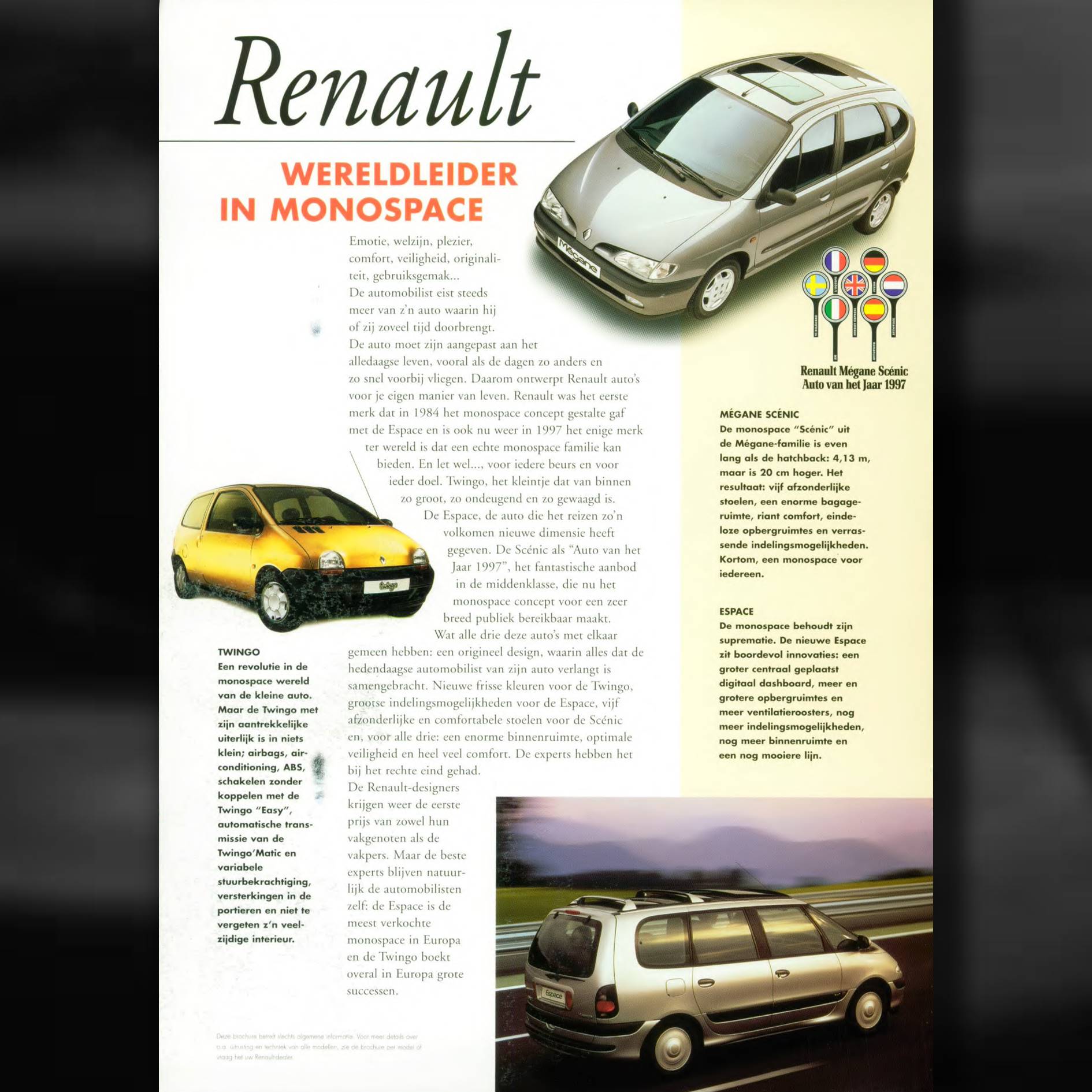
The idea for the Mégane Scénic was perhaps not entirely unique. The Scénic Concept from 1991 was very well thought through, but if I remember well, there were more similar concept cars at that time. And Mitsubishi had had the Space Runner since 1991, which is reasonably similar in size to the Mégane Scénic. Yet the latter offered something new for the European buyer. I think it was a good move of Renault to initially launch the model as part of the Mégane series. That made it a 'more ordinary' model, a less eccentric purchase for the average worker. At the same time, it was a very practical family car, with many storage compartments and a flexible interior – all for considerably less money than you had to pay for an Espace. Renault mastered the concept of the MPV like no other European brand and managed to make it accessible to the general public in a car that looked like a family car, and not like a van. Judging by my school diary, also I appreciated that concept as a schoolboy: in addition to an overview of Cars of the Year since 1964, I wrote “1997 → ik denk, hoop, gok: …Renault Mégane Scénic” (“1997 → I think, hope, guess:… Renault Mégane Scénic”). I thought, hoped and guessed well, it turned out later, because the midi-MPV would indeed become the European Car of the Year 1997, with a big lead over the other nominees and the highest score since the Peugeot 405 in 1988.
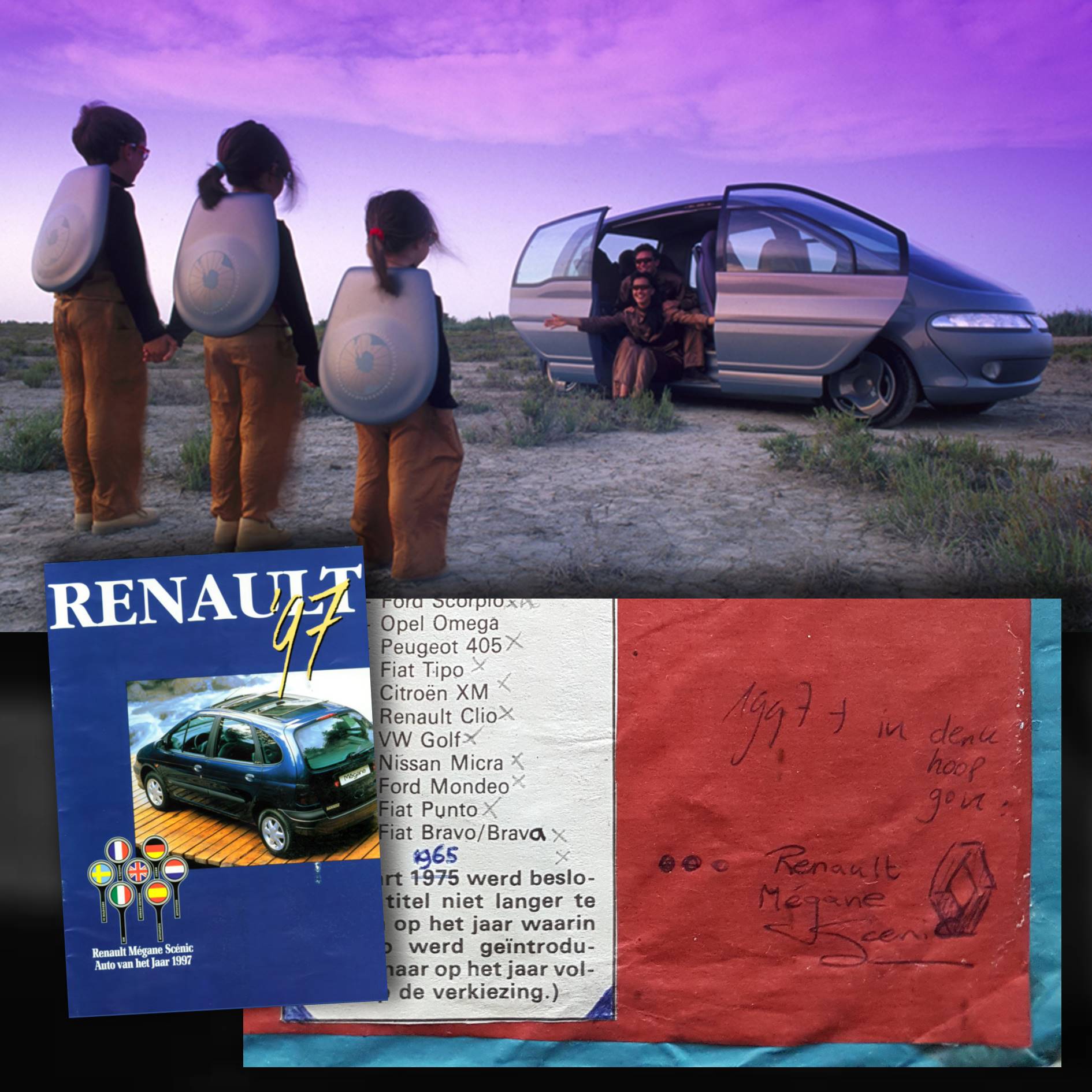

Renault Mégane Scénic
A high MéganeIn 1995, Renault presented the Mégane as the successor to the 19, initially only as a five-door hatchback and as a three-door hatchback that was given the name 'Coupé'. In the same year I, a 12 year old boy, received a booklet for Sinterklaas, entitled 'Alle Auto's 96' ('All Cars 96'). Every year in December a new part came out, with the date of the coming year in the title. In that booklet was an image of the new Mégane in various body styles, some of which had not yet been revealed. At the time, an average model series of compact family cars consisted of a 3-door and 5-door hatchback, a sedan and station wagon, possibly supplemented with a coupé and/or convertible. In the case of the Mégane, however, there was no station wagon (or break, as the French often call such a model), but a high model, a kind of small Espace.

The first image I saw of the Mégane Scénic
A small EspaceIt is of course impossible to say with certainty how I would have described the Mégane Scénic in 1995 when I saw that first, darkened image. I may or may not yet have known the term 'MPV'. But I certainly knew the Espace, Renault's large family van. (To European standards it is a large car, but in the US people carriers like this are called mini vans...). I therefore think there's a good chance I would have described the new phenomenon that was the Mégane Scénic as 'little Espace'. That probably applied to many people at the time. And with reason. Renault had already taken on the role of precursor – whether they really were, I'll leave aside for now – at the introduction of the first Espace in 1985. The design came from Matra, who first offered it to Peugeot. When that brand refused the model, they went to Renault, which jumped at it. In 1985 the car came on the market as Espace. A striking name, because it surely did offer a lot of espace (space). The model turned out to do well enough to justify a successor, and in 1991 the second generation Espace was presented. When MPV's came into fashion in the mid-1990s, Renault already had years of experience and their brand name in Europe was already inextricably linked to that concept. Where Renault's largest European competitors focused on the development of an Espace-like car (the Citroën Evasion/Fiat Ulysse/Peugeot 806 hit the market in 1994, the Ford Galaxy/Seat Alhambra/VW Sharan in 1995-1996 and the Opel Sintra in 1997), Renault could already think one step further, towards a midi-MPV.

The first Espace (1985)
A big TwingoBefore the Mégane Scénic saw the light of day, Renault had already added another MPV next to the Espace: the Twingo. It may be a bit too far to see that car as an MPV, but for a small city car it offered a remarkable amount of interior space. Renault later advertised with the Twingo, Mégane Scénic and Espace as a mono-volume line-up. With the Twingo, Renault also profiled itself as a forerunner, although in Japan a car with a similar concept was already for sale under the Honda brand, and in Europe Citroën, for example, had already considered a similar concept for the AX. That of course doesn't alter the fact that it was Renault that had the courage to bring such a remarkable model to the European market. And that it contributed to the image of Renault, as a brand that, in addition to rather 'average' models, was also strong in smart space concepts.

'Renault, world leader in monospace': Twingo, Mégane Scénic and Espace
A convincing Car of the YearThe idea for the Mégane Scénic was perhaps not entirely unique. The Scénic Concept from 1991 was very well thought through, but if I remember well, there were more similar concept cars at that time. And Mitsubishi had had the Space Runner since 1991, which is reasonably similar in size to the Mégane Scénic. Yet the latter offered something new for the European buyer. I think it was a good move of Renault to initially launch the model as part of the Mégane series. That made it a 'more ordinary' model, a less eccentric purchase for the average worker. At the same time, it was a very practical family car, with many storage compartments and a flexible interior – all for considerably less money than you had to pay for an Espace. Renault mastered the concept of the MPV like no other European brand and managed to make it accessible to the general public in a car that looked like a family car, and not like a van. Judging by my school diary, also I appreciated that concept as a schoolboy: in addition to an overview of Cars of the Year since 1964, I wrote “1997 → ik denk, hoop, gok: …Renault Mégane Scénic” (“1997 → I think, hope, guess:… Renault Mégane Scénic”). I thought, hoped and guessed well, it turned out later, because the midi-MPV would indeed become the European Car of the Year 1997, with a big lead over the other nominees and the highest score since the Peugeot 405 in 1988.

The Scénic Concept (1991), a brochure from 1997 and an excerpt from my school diary
MY CLASSICS
In the My classics section, I add a model to my digital collection of classics every other week. For that, I select cars whose design appeals to me or evokes memories. So nostalgia, and very subjective. Hence the section title: my classics.
In the next episode: A small space wonder...
Sources
- The AutoWeek Carbase.
- Images: Kempen, R. van. (1995). Alle Auto's 96; KNAC autojaarboek. Alkmaar: Uitgeverij de Alk b.v.; Dutch brochures via autoweek.nl; This and this article from group.renault.com.
